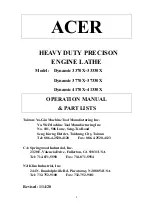
25
PROCEDURE FOR RE-STARTING THE MACHINE
AFTER A POWER FAILURE OR OVERLOAD
CL3-CAM Lathe
The CL3 lathe is fitted with a no volt release (NVR) switch which will cut
out in the event of a power failure preventing automatic re-starting when
the power source is restored.
If the machine stalls due to overloading (following a dig in whilst turning),
switch the machine OFF by pressing the red button marked ‘O’. Rectify the
source of the overload and rotate the work piece by hand to ensure that it
can rotate freely before attempting to re-start the lathe.
CL4-CAM Lathe
The CL4 lathe does not have a no volt release (NVR) switch, but the inverter
drive unit incorporates low voltage and overload sensors.
The low voltage sensor will prevent automatic re-starting of the lathe when
the power source is restored.
If the machine stalls due to overloading (following a dig-in whilst turning),
switch the machine OFF by pressing the red button marked ‘O’. In cases
of severe overload, the overload sensor will cause the inverter to cut out
negating the need to switch the machine OFF. Rectify the source of the
overload and rotate the work piece by hand to ensure that it can rotate
freely before attempting to re-start the lathe. Ensure that the speed control
is returned to its lowest setting before attempting to re-start the machine.
Gradually increase the speed back to the required level before applying the
turning tool.
CAUTION!
Before carrying out any adjustments or maintenance ensure that
the machine is isolated and disconnected from the
electricity supply.
SPEED SELECTION
Speed (RPM) controls the quality and safety of the work. Too slow and the
finish will not be smooth. Too fast and the work can fly off the lathe causing
damage and risking severe injury. Follow these steps to obtain the correct
speed.
1. Remove the tool rest from the lathe.
2. Trim work before turning the lathe ON. Mount work on the lathe and spin
it by hand. Imbalance is the result of one side being heavier than the other.
Trim excess with a saw, sander, chisel or other means before turning the
lathe on.
WARNING:
Unbalanced workpieces can be thrown off the lathe at high
speed. You can be seriously injured if hit by flying pieces. Always wear a
face shield or suitable protection and ensure work is mounted securely. Start
with a slow speed at first and build up to optimum speed only when the
work becomes roughed out and balanced.
3. Set spindle speed to lowest speed and replace headstock cover if
necessary, before turning the lathe ON.
4. Stand to the side of the workpiece when turning the lathe ON. So that if
the work does fly off, you will not be in its path.
If, after letting the workpiece rotate at the slower speed, you are satisfied
that it rotates safely, stop the machine, replace the toolrest and begin to
rough out the work piece.
5. Adjust to a higher speed only after roughing out to achieve a balanced
workpiece.
WARNING:
Excessive speeds can cause the workpiece to break apart,
throwing pieces in all directions. Always use the lowest speed that produces
acceptable results. Any item that cannot be turned over the bed bars –
MUST be turned using the lower speed range.
Most turning can be safely and effectively achieved between 400 and
2000 rpm. The additional speeds achievable with this unit are for specialist
turning such as high speeds for miniature work, pens and lace bobbins and
slow speeds for thread cutting for example. These speeds are only to be
used by experienced turners who have had adequate training and observe
all recommended safety and operating procedures.
Refer to speed chart shown below for pulley / speed details.
PULLEy SPEED RANGES
By changing the belt on to each of the five different pulleys the speed can
be varied from 425 to 2000 rpm on the CL3-CAM and 13 to 4648 rpm on
the CL4-CAM.
WARNING:
For your own safety, turn OFF and remove plug from power
source before making any adjustments.
1. Ensure that the grub screws in the two pulleys are fully tightened. It is
advisable that these should be checked periodically, (two grub screws per
pulley). Remove outer grub screw before tightening fully the inner dog grub
screw then re-place outer grub screw to lock in position (see
section 6
).
2. Adjustment of the tailstock along the lathe bed rails is obtained by
releasing the
tail stock cam lock,
Fig 9.1
and moving the tailstock to
the desired position, then lock firmly. When working between centres, the
tailstock centre is positioned in the workpiece by means of the tailstock
hand wheel. The barrel is then locked in position by the
tailstock centre
lock Fig 9.1
.
3. Adjustment of the toolrest base on the lathe bed rails is achieved by
slackening the
tool rest cam lock Fig 9.1
and moving it to the desired
position, then locking firmly.
4. Adjustment of the toolrest is obtained by releasing the
toolrest locking
handle 9.1
and moving the toolrest to the desired position, then lock
firmly using the
toolrest locking handle,
Fig 9.1
.
5. Always ensure that the adjustments mentioned above have been
followed by firm clamping before starting the lathe and always turn the
workpiece by hand to ensure it will not foul on any part of the lathe.
Please note:
Sensitivity of the cam handles can be adjusted using the
nyloc nut. See
section 6
-
Attaching the Tailstock
and
Banjo &
Toolrest Assembly
.
10. Lathe Operation
i
Kg
i
Kg
i
Kg
i
Kg
i
Kg
i
Kg
Summary of Contents for CL3-CAM
Page 20: ...20 6 Assembly Instructions cont Fig 6 46 Fig 6 47 ...
Page 35: ...35 13 Spare Part Identification VSLK for CL4 CAM only ...
Page 46: ...46 ...
Page 47: ...47 ...









































